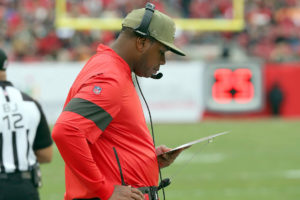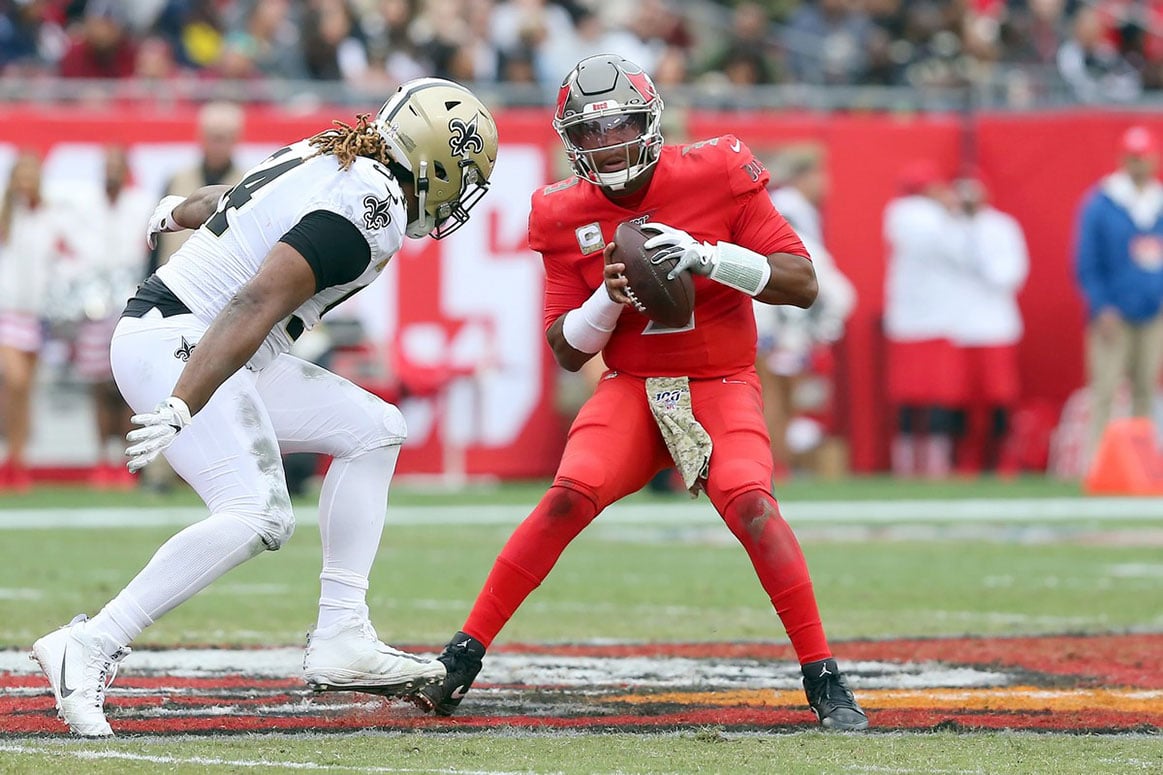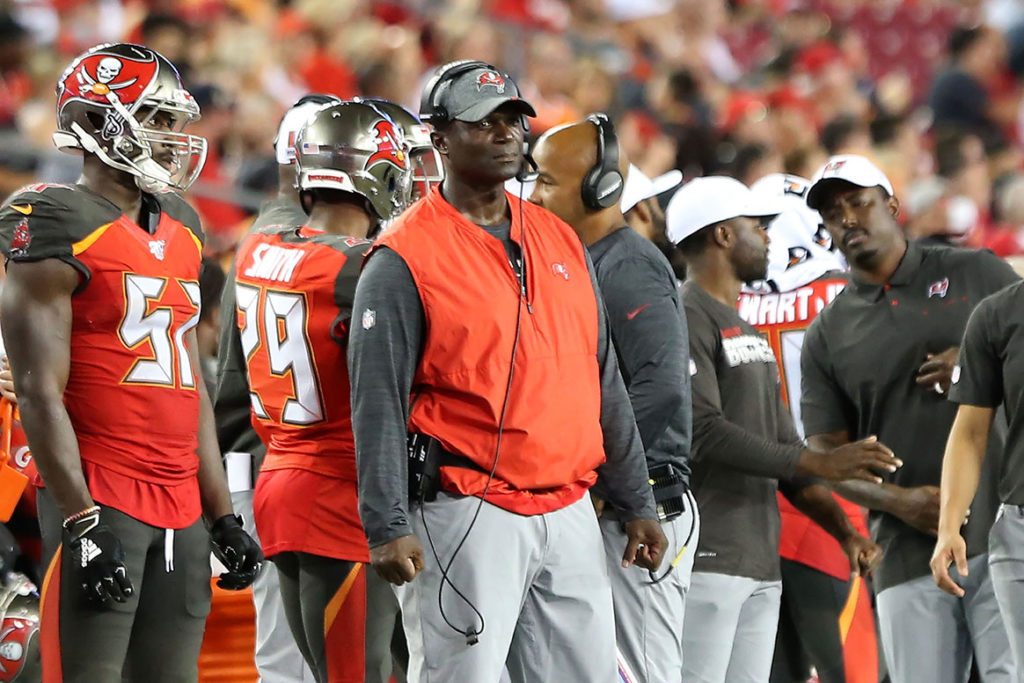Cover 3 is a weekly feature column written by PewterReport.com’s Tampa Bay Bucs beat writer Trevor Sikkema published every Tuesday. The column, as its name suggests, comes in three phases: a statistical observation, an in-depth film breakdown, and a “this or that” segment where the writer asks the reader to chose between two options.
Sikkema’s Stat of the Week
Following the 2016 NFL season, the offseason strategy for the Buccaneers was clear: Weapons for Winston. The Bucs were coming off a 9-7 season with Dirk Koetter as head coach, and with an offensive mind at the helm, the thought process going into the curve of 2017 was centered around getting their young franchise quarterback, Jameis Winston, all the offensive weapons he could handle.
The previous year, wide receiver Mike Evans was the leading pass catcher with over 1,300 yards, but after him it was wide receiver Adam Humphries with 622 and tight end Cameron Brate with 660. They needed more fire power. So what did they do? They signed wide receiver DeSean Jackson in free agency, and drafted tight end O.J. Howard and wide receiver Chris Godwin in the 2017 NFL Draft. All three of those players were being added to the offensive arsenal without losing any of Evans, Humphries and Brate.
Weapons for Winston achieved.
Fast forward to the present day and the Bucs continue to have one of the most potentially potent and attractive offensive cores in the NFL. Yet here they sit at 3-7, staring down the likelihood of a third straight 5-11 season.
What gives? I thought this was an offensive age? Isn’t that what’s supposed to win football games in today’s NFL. Well, yes, but it’s still about getting the most out of your offense, not just getting something out of it.
When head coach Bruce Arians took the job in Tampa Bay, he did so for a number of reasons. For one, he hated broadcasting. Two, he had a good relationship with the current general manger Jason Licht. And three, he thought there was a ton of talent on this roster, especially on offense.
He wasn’t wrong, but here we are 10 games in and they can’t figure out how to turn their yards and scores into wins.
 Byron Leftwich is the Buccaneers current offensive coordinator and play caller. The Bucs thought they were hiring Arians to call plays, as he has throughout his entire coaching career. But Arians informed the Bucs decision makers that he would not be doing that and instead sang the praises of Leftwich, assuring them that he was a rising star of a coach in this league.
Byron Leftwich is the Buccaneers current offensive coordinator and play caller. The Bucs thought they were hiring Arians to call plays, as he has throughout his entire coaching career. But Arians informed the Bucs decision makers that he would not be doing that and instead sang the praises of Leftwich, assuring them that he was a rising star of a coach in this league.
Rising maybe, but I would say a star yet.
This season has produced a lot of production from the Bucs offense. Godwin and Evans are the highest totaling receiving duo in the NFL, Winston is second in the NFL in terms of passing yards with already over 3,000 on the season, and the offense as a whole ranks sixth in points per game with just over 27.
But I’ll still tell you it hasn’t been what it could be, and while the Bucs defense certainly has not held its end of the bargain when it comes to weekly execution on Sunday, the offense and its play callers are also short of perfect.
I’ll start by saying this: I do not understand this team’s current offensive philosophy.
My biggest gripe with Koetter’s offense in 2017 and 2018 was how long it demanded Winston to hold onto the ball in order for vertical routes to break, and also how it continually asked Winston to hit some of the hardest throws in the game (tight window throws deep down the sideline) with regularity. Every offense in the NFL asks its quarterback to do these things, but it felt like Tampa was asking it more than it needed to. It could have been simpler, easier for their quarterback, especially with the weapons they had.
When Arians came to town, he spoke with such confidence about what could fix Winston’s problems. I figured that this would be more passes over the middle, as Winston historically has a much higher completion percentage in that area, and much more quick-hit throws built into the offense that weren’t just slot out routes to the sideline (still difficult) or swing passes out of the backfield.
But I’m not really seeing that. It’s still really vertical with a lot of tight window sideline stuff.
Take a look at some of these Next Gen Stats measuring average separation, which is the average distance between a receiver and the nearest defender at the point of the catch, and then targeted air yards, which measures the yards downfield at the time of all passing attempts that the receiver is the target.
Avg Seperation:
Chris Godwin: 2.6 (75th)
Breshad Perriman: 2.6 (78th)
Mike Evans: 2.3 (109th)
Targeted Air Yards:
Mike Evans: 15.5 (2nd)
Breshad Perriman: 13.5 (27th)
Chris Godwin: 10.4 (55th)
Long routes, not a lot of separation. Let’s take it a step further and check out the average cushion yards defenders are giving these receiver at the snap.
Avg Cushion:
Breshad Perriman: 6.8 (8th)
Chris Godwin: 6.5 (11th)
Mike Evans: 5.4 (79th)
Evans sees a lot of press coverage because he’s giant, so it makes sense that he is naturally lower with less cushion yards on average. But as a whole, on average, defenses are giving these Buccaneers receivers tons of room to work with at the snap, and yet defensive backs are still successful with it given the separation averages. This is because they know the Bucs offense is going to have their guys run long distances before the ball is thrown their way.
Finally, knowing the targeted air yards and the cushion given to each guy, let’s look at the expected yards-after-catch number for each, which measures the expected yards after catch, based on numerous factors using tracking data such as how open the receiver is, how fast they’re traveling, how many defenders/blockers are in space, etc
Exp. YAC:
Chris Godwin: 4.5 (59th)
Breshad Perriman: 4.2 (76th)
Mike Evans: 3.4 (99th)
It just doesn’t seem to be easy. It’s all vertical concepts that ask Winston to hold onto the ball for longer than one should behind this offensive line, and the designs of the routes are not creating open space for pass catchers to run with it after receiving the ball. This all went into my biggest drawback from what Koetter was doing, and it appears it has remained through the first year of Leftwich.
Though I do think the offense is being made more difficult than it needs to be, as stated before, this team is still putting up big numbers. But there’s another area of Leftwich’s rookie year as a full-time play caller that is hurting them, and that is in the decisions of the plays within the game itself.
We take a closer look at that on the next page.
Trevor Sikkema is the Tampa Bay Buccaneers beat reporter and NFL Draft analyst for PewterReport.com. Sikkema, an alumnus of the University of Florida, has covered both college and professional football for much of his career. As a native of the Sunshine State, when he's not buried in social media, Sikkema can be found out and active, attempting to be the best athlete he never was. Sikkema can be reached at: [email protected]



